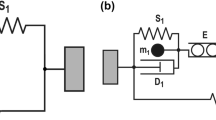Abstract
In the human, the antagonistic, extensor-flexor system of the leg is an example of a common type of neurophysiological feedback system. After a brief introduction to the neuroanatomy and physiology of this feedback system, the paper formulates transfer functions from temporal response data available in the literature. A feedback stability analysis, based on the extension of Nyquist's stability criteria to multiple-loop systems and utilizing flow-graph techniques, demonstrates the stable behavior of the system. Expressions are given relating the sensitivity of the system to variations in muscle response and Golgi tendon organ (tension receptor) response. By considering the events taking place at synapses and end-plates during “isometric tension-small knee angle excursion” conditions as stationary stochastic processes, an external “noise” input to the system is given, whose spectrum is derived from the statistics of a shot-process representation of these events. The paper concludes with some correlations between the analytical results and clinical syndromes.
Similar content being viewed by others
Abbreviations
- a :
-
effective reduction in tension on spindle for “quasi-isometric” conditions
- A, AT :
-
subscripts denoting agonist and antagonist, respectively
- α:
-
designation of a certain range of nerve fiber diameters
- D(t) :
-
impulse response of a pure delay element
- D(s) :
-
transfer function of delay element as a function of complex frequency (i.e., ratio of output to input)
- D α :
-
transfer function of α fiber
- D γ :
-
transfer function of γ fiber
- D ISF :
-
transfer function of intersegmental fiber
- D RC :
-
transfer function of recurrent collateral fiber
- D :
-
return difference (1−T l)
- δ(t):
-
Dirac delta-function of time
- db:
-
decibels
- Erf :
-
error function (see eq. (6))
- Erfc :
-
complementary error function (see eq. (3))
- F(t) :
-
component of postsynaptic potential, as a function of time
- F 1(a, b; c):
-
Kummer's confluent hypergeometric series
- f(PSP) :
-
probability density function related toPSP(t)
- G :
-
transfer function of an element in the multiple-loop system visualization
- GT(s) :
-
Golgi tendon organ transfer function, or frequency response, for complex frequencies
- GT(ω):
-
Golgi tendon organ transfer function, or frequency response, for real frequencies
- γ:
-
designation of a certain range of nerve fiber diameters
- h M(t):
-
impulse response of muscle (including endplate)
- K :
-
arbitrary constant
- K GT :
-
Golgi organ transfer function gain constant
- K M :
-
muscle transfer function gain constant
- K p :
-
amplitude constant ofF(t)
- K SP :
-
muscle spindle transfer function gain constant
- L 4−S1 :
-
denotes location in spinal cord, i.e., lumbar, sacral, etc.
- M(s) :
-
muscle transfer function, as a function of complex frequency; also muscle frequency response
- M(ω):
-
muscle transfer function, or frequency response, as a function of real frequency
- m:
-
meters
- mps:
-
meters per second
- ms:
-
milliseconds
- μ:
-
microns
- N(ω):
-
average spectrum for random arrival timest k ofF(t)
- ν:
-
average number ofPSP components arriving per second
- ω:
-
real frequency component of complex frequencys
- PSP(t) :
-
postsynaptic potential, as a function of time
- PSP(t) :
-
average value ofPSP(t)
- Ф D(ω):
-
phase shift in delay element as a function of real frequency
- R(t) :
-
temporal response of Golgi organ, or muscle spindle, to error-function of time “stretch”
- S :
-
sensitivity of system to changes in an element θ
- S(ω):
-
Fourier transform ofF(t)
- SP(s) :
-
muscle spindle transfer function, or frequency response, as a function of complex frequency
- SP(ω):
-
muscle spindle transfer function as a function of real frequency
- s :
-
complex frequency (s=σ+jω)
- T :
-
tension
- T:
-
over-all transfer function of a flow-graph in standard form
- T f :
-
forward transmission of a flow-graph in standard form
- T0:
-
direct transmission of a flow-graph in standard form
- T l :
-
loop transmission of a flow-graph in standard form
- t :
-
time
- τ:
-
delay time
- θ:
-
element under scrutiny, in standard form of flow-graph
Literature
Bode, H. W. 1945.Network Analysis and Feedback Amplifier Design. New York: D. Van Nostrand Co.
Eccles, J. C. 1957.The Physiology of Nerve Cells. Baltimore: Johns Hopkins Press.
Granit, R. 1955.Receptors and Sensory Perception. New Haven: Yale University Press.
—, 1958. “Neuromuscular Interaction in Postural Tone of the Cat's Isometric Soleus Muscle.”J. Physiol.,143, 387.
Lloyd, D. P. C. 1955. “Special Physiology of Nerves and Tracts,” inA Textbook of Physiology, ed, J. F. Fulton, chap. 4. Philadelphia: W. B. Saunders Co.
Author information
Authors and Affiliations
Rights and permissions
About this article
Cite this article
Adolph, A.R. Feedback in physiological systems: An application of feedback analysis and stochastic models to neurophysiology. Bulletin of Mathematical Biophysics 21, 195–216 (1959). https://doi.org/10.1007/BF02476360
Received:
Published:
Issue Date:
DOI: https://doi.org/10.1007/BF02476360




